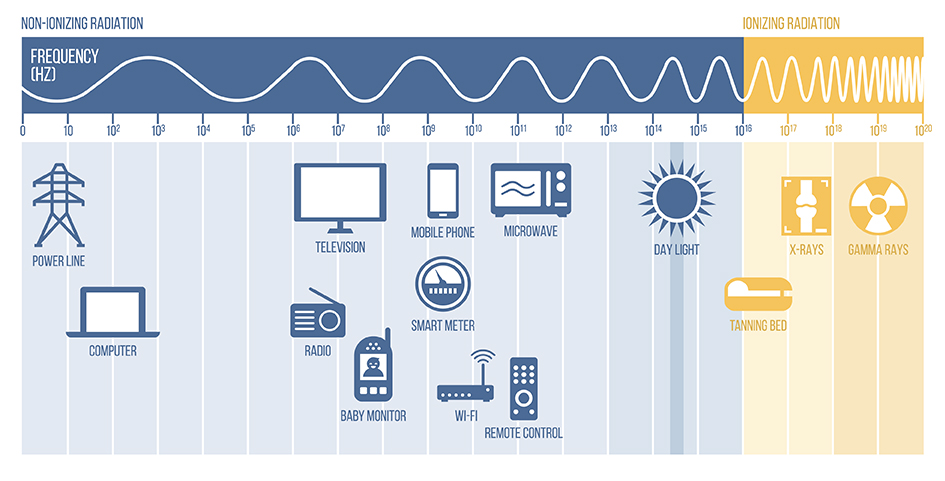EMF: Environmental Impacts of 5G
The roll-out of 5G has been the talk of the global town for quite some time now. This buzz topic carries with it a collection of controversies, conspiracies, and consequences; however, there is a fair share of us who are nothing short of ecstatic for the major boost in speed and connectivity in the realm of the Internet of Things (IoT), or as it’s quickly becoming the “Internet of Everything.”
While we were once a part of nature, we have now grown more apart from nature—so much so that we often forget to consider the consequences our actions have on the environment, especially when the short-term benefits cloud our consideration for the future. But we mustn’t forget that what’s bad for the planet is ultimately bad for us, and 5G has pulled a bit of a fast one on us.
Here’s what you need to know about the environmental impacts of 5G.
What Does 5G Look Like?
The latest iteration of wireless technology, while speculatively and subjectively the greatest thing that has ever happened to our digital world, doesn’t just magically appear with the flip of a master switch somewhere in the sky. For 5G to work as promised, a lot of new technologies, base stations, and devices had to be designed.
The road to the global roll-out of 5G is paved with many new parts, including millimeter waves instead of microwaves, small cell stations, a concept called beamforming, tens of thousands of new satellites, and new 5G compatible mobile devices.
A few of the terms above probably tripped you up a bit, so here’s a brief breakdown of what some of this new 5G-related vocabulary means and how they contribute to this next wave of the digital revolution.
Microwaves vs. Millimeter Waves
The main differences between microwaves and millimeters waves are their frequency spectrum and wavelength. Microwaves occupy the frequency spectrum between 1 GHz and 30 GHz, while millimeter waves are found between 30 GHz and 300 GHz. Wi-Fi, 2G, 3G, and 4G mainly rely on a frequency below 6GHz; 5G will use frequencies up to 120 GHz. The radiofrequency waves we currently use can measure tens of centimeters compared to millimeter waves, which are no longer than ten millimeters.

Traditionally, we’ve always employed the larger microwaves for most of our electronic devices and appliances, including our cellular networks. However, this spectrum has become increasingly congested as there are now so many users demanding access to it.
5G to the rescue!
The new 5G utilizes higher-frequency and much smaller millimeter waves, which will create a lot more space on the spectrum for the ever-growing number of people and devices demanding faster and more widely accessible connectivity. There will be so much freed up space that we can start fine-tuning “the Internet of Everything.” Isn’t that what we all want, unbridled digital connection? I mean, what could possibly go wrong?
According to a point made by Scientific American as Innovative Medicine shared in its complete EMF survival guide, “short-term exposure [to millimeters waves] can have adverse physiological effects in the peripheral nervous system, the immune system, and the cardiovascular system. The research suggests that long-term exposure may pose a health risk to the skin (e.g., melanoma), the eyes (e.g., ocular melanoma), and the testes (e.g., sterility.)
We aren’t the only animals on the planet, either.
See how we can help you restore complete health of body, mind & spirit.
We’ll send you special offers and cutting-edge info on how to heal smarter.
Small Cell Stations
The laws of physics state that the shorter the wavelength, the shorter the transmission range. This poses a problem for using millimeter waves to increase speed and connectivity. Fret not, though; all we need to do is install millions of small cell stations on trees, the sides of buildings, in public parks, next to our bedroom windows, and basically on any available space every 250 meters or so to eliminate dead zones and ensure that we are always connected. By 2022, China alone plans to build more than two million of these stations.
Beamforming
Were you one of those children who dreamed of being in the Broadway spotlight? Well, your dreams are about to come true! Beamforming is a technique similar to shining a spotlight on the star of the show that will need to be used to decrease the chances of millimeter-wave signals being dropped or crisscrossed. As explained by engineer Rajiv Baby, the way this works is “the precise location of the user device is continuously tracked using advanced software algorithms and base stations transmit signals only in the direction of the user’s location.”
Will 5G Affect the Environment?
Everything we do affects the environment in one way or another. As many of us are becoming more conscientious, we choose actions and behaviors that benefit or don’t negatively impact the natural world. Unfortunately, this is not one of those things, at least at this stage.
Countries, states, scientists, and individuals around the world stand in strong opposition to 5G not because they believe it’s linked to any conspiracy theories but because there haven’t been enough studies conducted on the long-term effects it will have on the global population, both human and non-human. What we do know at this point, though, is rather alarming.

5 Environmental Impacts of 5G
We are connected to everything and everyone. Our health is directly linked to the health of our planet. We may operate in an individualistic society, but the truth is, we are collectively connected and a global community united by a shared home. 5G isn’t just a faster network like the upgrade from 3G to 4G—there’s a lot more to it, and unless you actively seek out what it entails, that information doesn’t come as common knowledge. To be informed is a great strength, and in the age of the Google search bar, digging deeper is far from manual labor.
Here’s what we discovered on our great dig to unearth the top environmental concerns related to 5G.
Energy Consumption
The energy increase that goes hand and hand with 5G making its way around the world is substantial, and the timing couldn’t be worse; I mean, aren’t we trying to reduce our energy consumption to curb climate change? The ratio of available data to energy consumption with 5G is 1:1. In other words, if 5G is promising to deliver up to 1,000 times more data, which it is, that means doing so would consume up to 1,000 times more energy, according to Dexter Johnson’s write-up on IEEE Spectrum.
The International Telecommunication Union has published requirements on data rates, latency, and reliability that a network needs to demonstrate to be called 5G. They have also expressed a goal for greater energy efficiency. Still, they have yet to establish any measurable parameters that suggest their goal will be reached even though 5G is currently being rolled out.
Another report by the GSM Association stated that the telecom industry currently consumes around 3% of global energy. By 2026, thanks to 5G and all its components, energy consumption will jump 170%. Many experts are hopeful that once 5G’s infrastructure is in place, work can be done to increase its overall energy efficiency—but the goal, for now, seems to be to get it up and running and get everyone connected, then worry about the environmental and health issues later.
Infrastructure Boom
As mentioned earlier, for 5G to start working its magic, a lot of new infrastructures are needed, including satellites, MIMO base stations, small cells, and 5G compatible devices. We are essentially overhauling the entire system, and that requires a lot of nonrenewable metals and toxic chemicals.

According to the IEEE Communication Society, 50 base stations are needed per square kilometer since millimeter waves are very prone to interference from rain, trees, walls, and anything else in its direct transmission line. Next, between SpaceX, Amazon, Facebook, and OneWeb, it is estimated that 50,000 5G satellites will be added to orbit.
The life expectancy of these satellites is about five years. Then, to top it all off, all current cell phones, unless, of course, you already have a 5G cell phone, will need to be tossed out and replaced with a brand new 5G compatible device.
E-waste
According to a UN report, “the world produces as much as 50 million tons of electronic and electrical waste (e-waste) a year, weighing more than all of the commercial airlines ever made. Only 20% of this is formally recycled.” By 2030, it is estimated that this amount will increase to nearly 75 million tons.
The simple reason for this is that more people are buying electronic products with shorter life cycles and fewer options for repair. When it’s time to switch from 4G to 5G, a new phone will be required.
You’re probably thinking, where in the world does all this e-waste end up? Well, some ends up in our landfills, but a lot of it ends up in countries like Nigeria, Pakistan, and Ghana, where workers manually break down the items, sort through the parts, and sell anything that is of value. What’s not of value often makes its way into the waterways and out to sea.
E-waste contains many toxic chemicals, like arsenic, mercury, lead, barium, and chromium, which the e-waste workers are also exposed to for lack of safety regulations. The waste that ends up in a landfill can eventually contaminate the water table and affect surrounding communities. If you are going to throw away any electronic item, the best thing you can do is make sure you take it to an electronic recycling center or donate it if it’s still in working condition.
EMF pollution
Electromagnetic field (EMF) pollution is already an issue as we are currently living in a highly digitalized world. However, we can still limit our exposure by doing things like shutting off our Wi-Fi router and keeping our devices out of the bedroom at night, keeping our cell phones out of our pockets, avoiding Bluetooth earbuds, and keeping our laptops off our laps.
With 5G, it will be a bit tricker since the source of the higher-frequency millimeter waves will be all around us and in much closer proximity. This is a problem we will undoubtedly need to come up with a solution for. But, what about other mammals? How will this huge increase in EMF pollution affect our domestic and wild mammalian friends?
An independent research firm “found evidence indicating the 5G poses a major threat to all biological life.” Mammals also have similar reproductive organs, immune systems, and nervous systems as humans. For that reason, they are just as susceptible to the consequences of prolonged exposure to EMFs as humans are.
And let’s not forget that many animals also rely on the earth’s magnetic field for navigation and migration. The saturation of human-made EMFs certainly can interfere with the natural ones, the same way they interfere with our own internal electrical signals.
Insect Apocalypse
Whether you are absolutely enamored by them or truly terrified, insects are key to our survival and the survival of many plants and animals. One-third of our food production is dependent on pollinators like bees. Insects are vital members of nearly all terrestrial ecosystems and many aquatic ones too.
But we are currently in the midst of an insect apocalypse, with 40% of insect populations already in great decline due to pesticides, habitat destruction, nocturnal light pollution, and climate change.

A study published in 2018 by Scientific Reports brings up a new threat, 5G. The report points out the huge difference between wave frequencies generated by 4G and the latest 5G network. The wave frequencies for the 4G network never exceed 6Ghz and are harmless to insects.
The frequencies generated by 5G can reach up to 120GHz, which drastically affects insects’ body temperature and can cause great harm and death. The last thing we need is to lose more insects as our population continues to grow, and demands for food will continue to increase.
What Can We Do?
5G is happening, but it doesn’t have to be all doom and gloom from here on out. There are actions we can take to mitigate some of the environmental impacts of 5G. In doing so, not only will we be working toward a healthier future for our planet, but for ourselves and the next generations too. Here are the areas we need to focus on.

- E-waste recycling: Recycling consumer electronics helps to conserve natural resources and reduce air and water pollution, as well as the emission of additional greenhouse gases into our atmosphere. Many major electronic companies and stores, including Best Buy, Staples, HP, Dell, and Sony offer permanent drop-off sites, mail-in recycling options, or host e-recycling events. You can also search “e-waste recycling centers near me” to find out what’s available in your area.
- Habitat destruction: To mitigate the damaging effects of excessive e-waste, EMF pollution, the looming insect apocalypse, and climate change, a major shift from deforestation to reforestation needs to take place immediately. Habitat destruction is also greatly contributing to the loss of our global biodiversity, including insects. Our survival depends on the survival of the wild.
- Pesticides: The biggest threat to insect populations around the world is pesticides. We have the know-how to protect our crops from hungry insects without wiping out entire species. If 5G is going to have a monumental effect on the wellbeing of insects, we need to ensure that all the other threats are lessened to give them a fighting chance.
- Regenerative agriculture: This organic agricultural plan focuses on soil health, promotes biodiversity, and utilizes practices that help to sequester carbon and produce nutrient-dense food. This is what we need right now.
- Renewable energy: With the immense energy demand that will accompany 5G, it is crucial that we harness that power from renewable energy sources. Like organic insect control, we know how to do this—it just needs to be made the norm not the exception.
5G might have pulled a fast one on us, but together we can create actionable solutions to protect ourselves and the environment. The best way to begin is to start getting informed. And to keep in mind that what’s good for the planet is good for us!
Want more empowering information like this?
For more eye-opening and informative articles like this one, subscribe to Innovative Medicine.
The post EMF: Environmental Impacts of 5G appeared first on Innovative Medicine.
See how we can help you restore complete health of body, mind & spirit.
Lorem ipsum dolor sit amet, consectetur adipiscing elit, sed do eiusmod tempor incididunt ut labore et